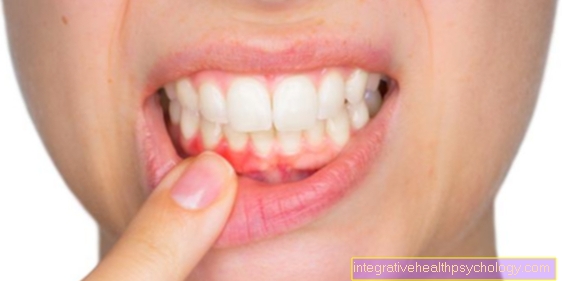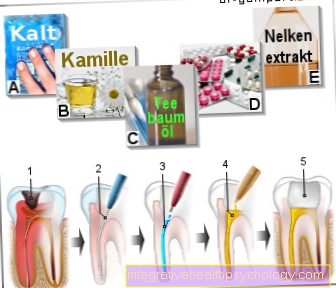Flush syndrome
definition
The flush syndrome is popularly also known as "blush" designated. From a medical point of view, flush syndrome is a symptom that can have many different causes. When flushing, reddening of the skin occurs like an attack, which is particularly evident in the affected patients face and Cleavage area occurs and is therefore clearly visible. As quickly as the redness occurs, it usually disappears on its own. The flush syndrome does not have to affect the entire face or the entire upper body, but can only occur locally in a few places.
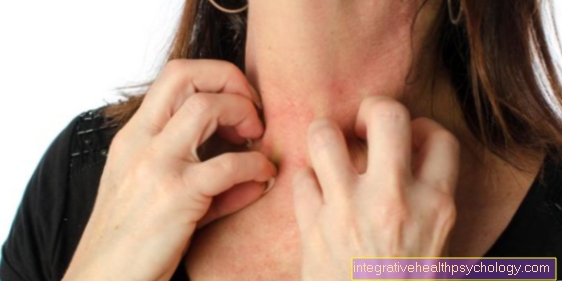
causes
A variety of different diseases and circumstances can be considered for flush syndrome. Psychological stress or increased excitement can lead to flush syndrome. For bigger ones physical exertionthat the patient provides, this also applies. With a detailed anamnesis, the above-mentioned triggers stress and exertion can often be found quickly, so that no further diagnostics appear necessary in these two cases.
Also eating from spicy foods can trigger flush syndrome. Above all, substances like the so-called play a role here Capsaicinfound in chili peppers plays an important role. It promotes blood circulation in the tissue and thus causes the flush syndrome with redness and a sensation of heat in the area of the face.
Also come as a cause for the occurrence of a flush syndrome elevated temperatures and fever in question. These often occur in the context of viral or bacterial infections and do not appear in everyday life after the infection has been overcome.
Flush syndrome can also occur in older women under Menopausal symptoms occur. Also the chronic inflammatory skin disease Rosacea can be the cause of flush syndrome.
Flush syndrome after taking cortisone
Flush syndrome can also occur as a side effect when taking medication. Here are above all so-called Calcium channel blockers or Nitrates to mention that under the Hypertension therapy can be used.
But also the drug Cortisone is a possible cause of flush syndrome. In the case of the above-mentioned drugs, the small blood vessels expand and lead to increased blood flow to the skin and thus to the triggering of flushing. A cortisone intake can be in addition to a Increase in blood pressure lead, which in turn promotes the development of flush syndrome. In addition, a possible hypersensitivity to cortisone is the reason for flush syndrome. Please also read our article on this Side effects of cortisone
Flush syndrome after taking Tecfidera
In the same way can stop taking the drug Tecfidera® possibly to a Redness of the face with a Feeling hot to lead. The drug Tecfidera contains the active ingredient Dimethyl fumarate. It finds application in the treatment of Multiple sclerosis, a nerve disease that causes the nerve fibers of the central nervous system to die. The flush syndrome occurs in a close relationship and a close temporal relationship to the intake of Tecfidera®. Flush syndrome is a common side effect and usually decreases the longer you take Tecfidera.
Please also read our article on this Tecfidera®
Flush syndrome in high blood pressure
Arterial hypertension, so-called high blood pressure, is another possible cause of flush syndrome. In most cases, flush syndrome only occurs after a prolonged period of significantly elevated blood pressure values, so that other symptoms usually appear at first. Possible accompanying symptoms are, for example, headaches or dizziness.
Due to the high blood pressure, the small blood vessels in the skin are supplied with more blood than would be the case with normal blood pressure. This leads to reddening of the affected areas of the skin, mostly on the face, and the flush syndrome sets in. Especially in so-called blood pressure crises, when the blood pressure temporarily increases in an uncontrolled manner, the symptoms become more pronounced.
Flush syndrome with an allergy
An allergy can also cause flush syndrome. An allergy is a hypersensitivity reaction of the body to certain substances (Allergens). If you are allergic to a certain substance, for example to certain bee pollen, contact with the allergen leads to a massive release of histamine from the body cells. Histamine is a kind of messenger substance. In the blood vessels, the histamine dilates the vessels and increases their permeability for fluid. It eventually comes to one increased blood flow the skin and thus, among other things, the occurrence of a flush syndrome.
Flush syndrome after drinking alcohol
Drinking alcohol can also lead to flushing syndrome. It occurs frequently in the context of alcohol breakdown disorders. Mostly people from the Asian region are affected because they have a genetic change in the enzyme activity of the so-called Acetaldehyde dehydrogenase is reduced. However, this enzyme plays an important role in the Alcohol breakdown. A low level of activity cannot properly break down the alcohol and the result is flush syndrome with a feeling of heat and flushing of the face. This "disease" is also called Alcohol intolerance or Alcohol intolerance designated.
In relation to alcohol and flush syndrome is also the so-called Acetaldehyde syndrome to call. This leads to "poisoning" with alcohol due to an inhibition of degradation. The cause of the inhibition of the breakdown of alcohol can be the intake of certain medications such as antibiotics from the group of Cephalosporins, e.g. Be cefuroxime.
Please also read our article on this Cefuroxime and alcohol - are they compatible?
Likewise, the drug can Disulfiram, which is used in the context of alcohol cessation, inhibit degradation. Since the alcohol is not properly broken down, the toxic one accumulates Acetaldehyde, which is an intermediate stage in the breakdown of alcohol. This mechanism then leads to the development of flush syndrome.
Flush syndrome due to a tumor
Another cause of flush syndrome can also be benign and malignant tumors. The main focus here is on tumor diseases, which are the messenger substances Serotonin or Catecholamines to produce. Important representatives in this context are carcinoids, which are often found in the area of the appendix process, but also the so-called Pheochromocytoma, which is a tumor of the adrenal medulla. The adrenal gland is located at the upper pole of the kidney and consists of cortex and medulla and is used for hormone synthesis (s. Adrenal hormones).
In carcinoid tumors, a flush syndrome only occurs when the tumor has already metastasized to the liver.
Diagnosis
The flush syndrome can have a multitude of possible causes, so that a general diagnosis cannot be named. The most important measure at the beginning of the diagnosis is a detailed anamnesis (questioning) of the patient concerned. Questions about the occurrence, frequency and duration of the flush syndrome as well as possible accompanying symptoms, such as diarrhea, weight loss or stress, are of particular interest.
A survey on medication consumption is also particularly important in this context.
High blood pressure (see high blood pressure) as a possible cause can be ruled out by measuring the blood pressure several times and having a 24-hour blood pressure measurement done. If you have a suspicion of what causes flush syndrome, the next step is to use some more complex diagnostic methods, such as imaging procedures or laboratory tests.
If there is a suspicion of a mass, i.e. a tumor, an ultrasound examination of the abdomen or an X-ray of the chest can be arranged, for example.
In addition, some values can be determined in the blood or urine that can allow conclusions to be drawn about a cause of the flush syndrome. They include the breakdown product of the hormone serotonin (the 5-hydroxyindolylacetic acid) and the Chromogranin-A, which is a tumor marker for pheochromocytoma. This is a tumor of the adrenal cortex that is typically associated with flush syndrome and can cause high blood pressure.
Please also read our article Pheochromocytoma and high blood pressure
therapy
The treatment of flush syndrome depends on the particular trigger of the symptoms. The flush syndrome occurs as a side effect of the Taking medication on, then you can use the triggering drug drop or another preparation move. When taking Tecfidera®, the flush symptoms should decrease over time and eventually disappear completely.
Does it come under the Eating or while drinking from alcohol To a flush syndrome, the same applies here to the appropriate food too avoid.
When flush syndrome is part of a allergy there are numerous drugs that are used in therapy. These include above all so-called Antihistamines and Cortisone supplements.
Is it because of a Tumor disease before the flush syndrome occurs, the underlying disease must be treated. Depending on the stage and extent of the tumor, one comes operational Therapy, one chemotherapeutic Treatment or a radiotherapy for use.
How can you avoid a flush?
Flush syndrome can only be avoided in certain situations. If there are underlying organic diseases, the symptoms can only be suppressed with difficulty. However, a flush due to stress, excitement or the ingestion of certain substances can be avoided. First of all, this includes avoiding stressful situations and excitement. If there is concomitant high blood pressure, this should be treated with medication or through lifestyle adjustments. Lifestyle habits that can reduce flush syndrome include exercise, a healthy and low-salt diet, fresh air and a reduction in alcohol.
Which doctor treats flush syndrome?
The flush syndrome must be treated on an interdisciplinary basis, depending on the cause. For an initial diagnosis and classification of the potential causes, it is advisable to visit an internist or general practitioner. Many possible causes such as stressful situations or drug side effects can already be remedied by the general practitioner. In order to clarify further illnesses, it may be necessary to work with an oncologist (cancer specialist) and a radiologist.
Duration
The duration of the flush syndrome is difficult to estimate as it depends entirely on the underlying cause. The typical flush reaction to certain everyday reactions, foods or temperatures usually subsides within a short time or after removing the trigger. Flush syndrome at high temperatures or during exercise can persist for the entire duration of exposure and then resolve within a few minutes. There is also often a drug cause behind the flush. The flush syndrome usually lasts for a few minutes to a few hours and then subsides again. However, as long as the drug is taken regularly, a further occurrence of the flushing can be expected.
forecast
It is also difficult to generalize the prognosis for flush syndrome. In most cases, some people have a general predisposition to blush in certain situations. If, on the other hand, flush syndrome occurs as a result of drug treatment or a disease, the prognosis depends on this underlying cause. When the drug is discontinued, a decrease in flush syndrome can be assumed. A flush syndrome due to a tumor disease, on the other hand, can have very different prognoses. When the tumor is healed, the metabolism is usually normalized, so the symptoms do not appear.









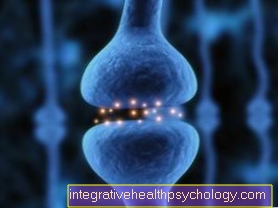
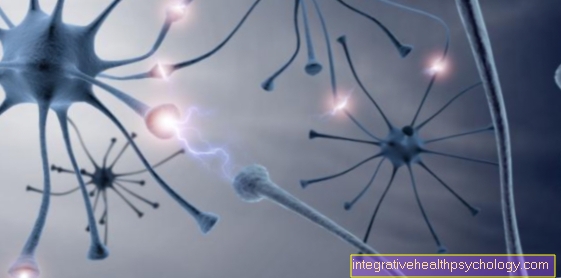






.jpg)
